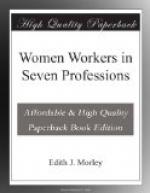[Footnote 6: The practice of the Girl’s Public Day School Trust, largely followed by other governing bodies, is to give the Head the right of nomination, and of dismissal during the probationary period subject to the veto, rarely exercised, of the Committee.]
[Footnote 7: Miss I.M. Drummond loc. cit.]
[Footnote 8: This is surely a better solution than that proposed in the November 1913, Educational Supplement to the Times. The suggestion is there made that the “conventual system” prevailing in some girls’ boarding-schools should be changed by having Headmasters instead of Headmistresses. The writer apparently fails to realise that one of the greatest difficulties in co-educational schools is to attract the right sort of mistress, because there is no prospect that she may ultimately attain a headship. The same danger will inevitably arise in any schools which introduce Headmasters. If the masculine element is desirable, and we agree that this may well be so, the obvious course is either to have some male assistants, or to have married house-mistresses, on the analogy of the married house-master at boys’ schools. A still better solution, in our opinion, is co-education, with pupils of both sexes, a mixed staff, and a joint Headmaster and Headmistress. In many of the new County and Municipal Secondary Schools this innovation has been successfully adopted, though the Senior Mistress is unfortunately in all cases definitely subordinate to the Headmaster. [EDITOR.]]
IV
ELEMENTARY SCHOOL TEACHING
Progressive women to-day resent the social system which requires them to be economically dependent upon others. They realise that social service needs labour of a highly skilled variety, and they therefore demand, on the one hand, training for their work as a guarantee of their efficiency in its performance, and, on the other hand, monetary payment and security of tenure as guarantees to them of economic independence. As a natural corollary to woman’s lack of political power, there are no spheres of professional work in which prevailing conditions are in these respects completely satisfactory. Perhaps the teaching service in the State schools comes nearest to complying with progressive demands: at any rate Government recognises the need for training, and, to a large extent, meets its cost; a salary, more or less adequate, is paid in return for the teaching given, and security of tenure is, with few exceptions, assured. Again, the work done in the State schools is now generally and rightly regarded as of first-rate importance to the community, and therefore as meriting national gratitude in the form of Government superannuation. Popular prejudice against compulsory education, once so strong, may now be said to have disappeared, and the work of the pioneers who endeavoured to create a public opinion in its favour, has borne fruit.




